
Solar Decathlon on the Mall offers lessons for all involved
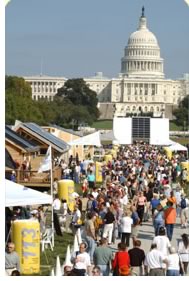 "Now,
more than ever, it is imperative that the public, clients, and policymakers
revisit the lessons of sustainability," AIA Executive Vice President/CEO
Norman L. Koonce, FAIA, told the Solar Decathlon contestants at the opening
ceremony September 26 on the Capital Mall. "The work you have done
will effectively raise the consciousness of the American public who will
ultimately determine—through the marketplace and through enabling
legislation—how pervasive energy efficiency and sustainability will
shape our interaction with one another and with the land."
"Now,
more than ever, it is imperative that the public, clients, and policymakers
revisit the lessons of sustainability," AIA Executive Vice President/CEO
Norman L. Koonce, FAIA, told the Solar Decathlon contestants at the opening
ceremony September 26 on the Capital Mall. "The work you have done
will effectively raise the consciousness of the American public who will
ultimately determine—through the marketplace and through enabling
legislation—how pervasive energy efficiency and sustainability will
shape our interaction with one another and with the land."
Koonce spoke on behalf of the AIA, one of four cosponsors of the 10-day event along with the organizers, the National Renewable Energy Laboratories and the U.S. Department of Energy. BP Solar, Home Depot, and Electronic Data Systems were the other three cosponsors.
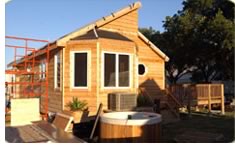 The
Solar Decathlon, in which architecture, engineering, business, and communications
student/faculty teams from 14 universities competed in 10 categories,
is intended to showcase energy efficiency and the harvesting of energy
from the sun. Education of students, homeowners, and all Americans is
the long-term goal of the event, said Energy Secretary Spencer Abraham
at the opening ceremony. Hoping to make it an annual event, Spencer said,
the Solar Decathlon is meant to show that people can enjoy a modern lifestyle
through harnessing the power of the sun.
The
Solar Decathlon, in which architecture, engineering, business, and communications
student/faculty teams from 14 universities competed in 10 categories,
is intended to showcase energy efficiency and the harvesting of energy
from the sun. Education of students, homeowners, and all Americans is
the long-term goal of the event, said Energy Secretary Spencer Abraham
at the opening ceremony. Hoping to make it an annual event, Spencer said,
the Solar Decathlon is meant to show that people can enjoy a modern lifestyle
through harnessing the power of the sun.
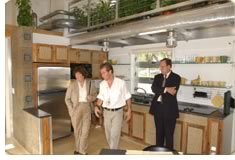 President
Bush is interested in sources of renewable energy because it protects
our future, Abraham told the crowd minutes before he cut the ribbon to
begin the competition. By learning to use energy more efficiently and
developing renewable energy sources, we will have a more energy-independent
America, he said, vowing to make prominent mention of the Solar Decathlon
during the DOE 25th anniversary celebration later this year. "I wish
you lots of good luck and lots of sunlight," Abraham quipped as the
opening ceremony was accompanied by the first rain in the District of
Columbia for over a month.
President
Bush is interested in sources of renewable energy because it protects
our future, Abraham told the crowd minutes before he cut the ribbon to
begin the competition. By learning to use energy more efficiently and
developing renewable energy sources, we will have a more energy-independent
America, he said, vowing to make prominent mention of the Solar Decathlon
during the DOE 25th anniversary celebration later this year. "I wish
you lots of good luck and lots of sunlight," Abraham quipped as the
opening ceremony was accompanied by the first rain in the District of
Columbia for over a month.
The 10 events
In keeping with the goals of public education and modern lifestyle, the
10 events in the competition are:
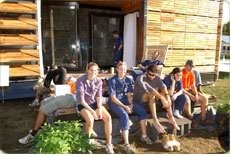 •
Design and Livability (200 points maximum): Have design, innovation,
aesthetics, and renewable energy technologies been successfully integrated
into a pleasing domestic environment? Winner: University of Virginia
•
Design and Livability (200 points maximum): Have design, innovation,
aesthetics, and renewable energy technologies been successfully integrated
into a pleasing domestic environment? Winner: University of Virginia
• Design Presentation and Simulation
(100 points maximum): Do the predesign drawings, ccale models,
and computer-generated models effectively illustrate the construction
of the house and the simulation of its energy performance? Winner: Virginia
Tech
• Graphics and Communication (100
points): How effective are the Web site, newsletters, and other outreach
materials designed by the teams? Winner: University of Colorado at Boulder
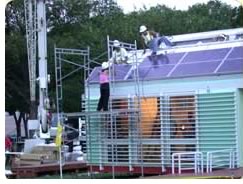 •
The Comfort Zone (100 points): Is the house designed to maintain
interior comfort through natural ventilation, heating, cooling, and humidity
controls while using a minimum amount of energy?
•
The Comfort Zone (100 points): Is the house designed to maintain
interior comfort through natural ventilation, heating, cooling, and humidity
controls while using a minimum amount of energy?
• Refrigeration (100 points):
During the competition, how consistently do the refrigerator and freezer
maintain interior temperatures while minimizing energy use?
• Hot Water (100 points): Does
the house demonstrate that it can supploy all the energy necessary to
heat water for bathing, laundry, and dishwashing?
• Energy Balance (100 points):
How well have the teams used only the sun's energy to perform all of the
tasks of the competition?
• Lighting (100 points): Is
the lighting of the house elegant, of high quality, and energy-efficient
both day and night?
• Home Business (100 points):
Does the house produce enough power to satisfy the energy needs of a small
home business?
• Getting Around (100 points):
Does the house generate enough energy to power a street-legal electric
vehicle to get around town?
And the winners are . . .
Click here for the latest rankings.
Copyright 2002 The American Institute of Architects. All rights reserved.
![]()
|
Full text of opening ceremony remarks by Norman L. Koonce, FAIA. The winners listed are as of press time. For the standing tallies, visit the Solar Decathlon Team Rankings. |
|